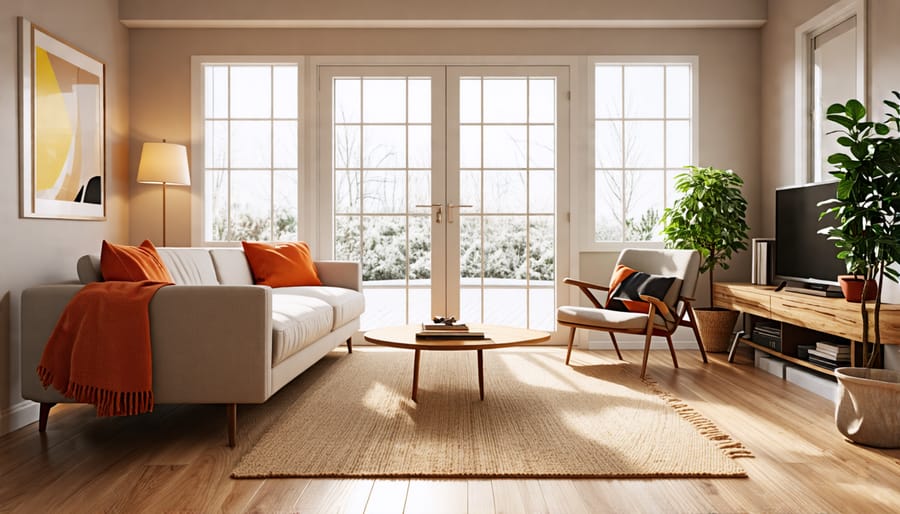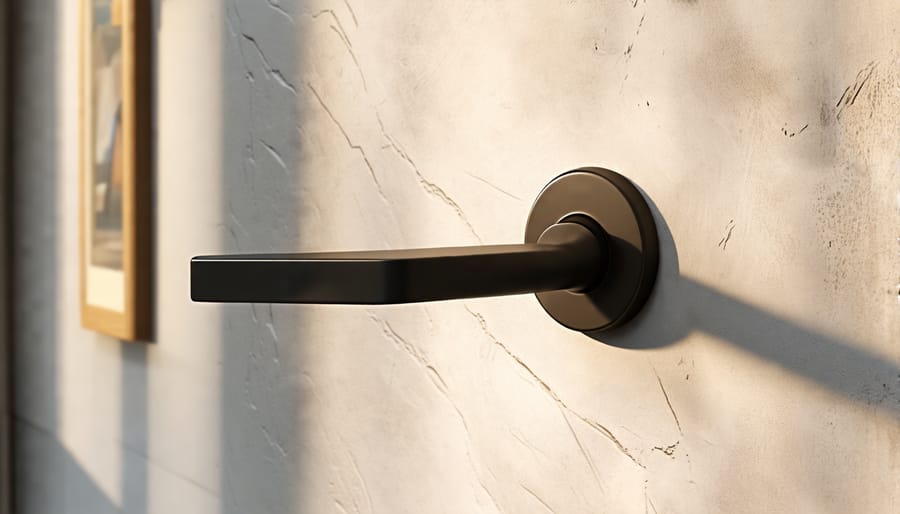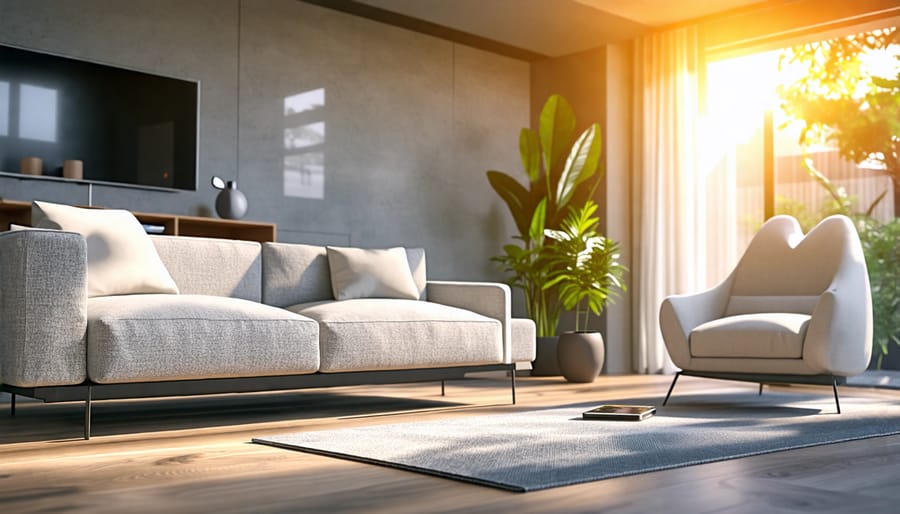Enhance accessibility by installing grab bars in strategic locations such as bathrooms and hallways, ensuring a secure and safe environment. Transform doorways by using offset hinges or widening them to accommodate mobility devices easily. Incorporate smart home technology like voice-activated lights and thermostats to bring convenience and independence to everyday tasks. Prioritize non-slip flooring options throughout your home to prevent accidents and provide stable surfaces for walking.
Why Home Accessibility Matters

The Growing Need for Accessible Homes
As our population ages and more people choose to live independently, the demand for accessible homes is growing rapidly. This trend isn’t just about aging—it’s also driven by a desire for more inclusive homes that accommodate individuals with diverse needs. Young families are considering future-proofing their spaces, realizing that adaptable designs can offer long-term benefits. Moreover, with more individuals embracing remote work and hybrid lifestyles, homes need to be versatile and accommodating. People are looking for creative ways to ensure their living spaces are comfortable for everyone, whether it’s through ramp installations, wide doorways, or user-friendly technology. By incorporating accessibility features, homeowners can not only improve quality of life but also increase property value, making it a win-win situation for everyone involved.
Benefits Beyond Accessibility
Creating an accessible home offers a range of advantages that extend beyond aiding those with mobility challenges. An accessible design enhances comfort and safety for everyone, making daily routines smoother and more enjoyable. Wider doorways and open layouts make it easier to move through the space whether you’re juggling groceries or entertaining guests. Handrails and non-slip surfaces provide extra security, while thoughtful design improves overall functionality. Moreover, these features can be seamlessly integrated with eco-friendly decor, adding sustainability to the equation. Investing in such design not only future-proofs a living space but adds value to it, accommodating the evolving needs of all family members over time. Accessible environments create inclusive spaces where everyone can thrive.
Key Accessibility Features for Your Home
Entryway Adjustments
Creating an accessible entryway is a welcoming improvement for any home. Start by considering ramps, an essential addition for wheelchair users or anyone who struggles with stairs. These can be professionally installed or tackled as a DIY project with prefabricated kits available to suit various styles. When building your own ramp, expert tips suggest using slip-resistant materials and ensuring the slope is gradual for easy navigation.
Wider doorways are another game-changer, allowing for smooth transitions for wheelchairs and walkers. This modification might involve removing a door frame or converting a single door to a double door. Though more complex, the results are worthwhile for ease of movement and your home’s resale value.
If a complete overhaul isn’t feasible, threshold ramps are a simple alternative, bridging gaps at doorsteps. For those up for a challenge, consider replacing handles with lever designs for smoother opening. Small adjustments can significantly enhance accessibility, embracing a friendly and functional home environment for everyone.
Bathroom Modifications
Transforming your bathroom into a safer, more accessible space doesn’t have to be daunting. Start with walk-in tubs, which offer ease of access for those with limited mobility, minimizing the risk of slips and falls. These tubs typically feature a watertight door, allowing for easy entry without the high step of a traditional tub. Complement this with strategically placed grab bars near the shower, toilet, and bathtub. These bars can provide security and balance, especially on wet, slippery floors. For a DIY-friendly option, ensure that bars are securely screwed into wall studs to support maximum weight. Also, consider installing non-slip flooring or applying anti-slip treatments to existing surfaces for added safety. Small changes, like updating your bathroom fixtures to lever-style handles, can vastly improve usability for everyone, including those with reduced hand strength. With these simple modifications, your bathroom can become a welcoming space that suits everyone’s needs while maintaining its stylish charm.
Kitchen Renovations
Transforming your kitchen into an accessible and efficient hub can truly enhance your home living experience. Consider incorporating kitchen innovations such as adjustable countertops, which can be lowered or raised to a comfortable height with just a push of a button. This makes meal prep safe and easy for everyone, including those using wheelchairs. Opt for accessible appliances like side-opening ovens and dishwashers with detachable racks. These features not only enhance convenience but also promote independence. Embrace these thoughtful updates to create a kitchen space that’s warm, welcoming, and entirely functional for every user.
DIY Accessibility Solutions
Simple DIY Projects
Sprucing up your home to make it more accessible doesn’t have to be a daunting task. There are numerous simple DIY projects that can significantly enhance the usability of your space. One straightforward improvement is swapping out traditional door knobs for lever handles. Lever handles are easier to use, especially for those with limited hand strength or dexterity. With just a screwdriver and some elbow grease, you can transform an entryway handle in under an hour. Remember to choose styles that complement your home’s decor, merging functionality with aesthetics.
Another impactful DIY project is creating a temporary ramp. Whether it’s to navigate a small step or provide wheelchair access, constructing a ramp can make a big difference. Plywood and some anti-slip tape can be all you need for a short-term solution. Be sure to measure carefully and follow safety guidelines, ensuring the ramp is securely in place.
These projects require minimal tools and a bit of patience, but the rewards are substantial, offering independence and ease for everyone at home. By tackling these DIY improvements, you’re taking a positive step towards a more inclusive living environment. So gather your tools, take a deep breath, and start enhancing your space today!

Creative Upcycling Ideas
Transforming everyday items into accessibility enhancements can be a rewarding and practical approach to improving your home environment. By creatively upcycling, you can make your living space more accommodating to all its occupants. Take an old bookshelf, for instance; reposition it at a lower height to create a convenient storage solution that can be easily accessed from a seated position. This modification not only repurposes an existing piece but also enriches the space functionally.
Next, consider using curtain rods as towel bars in the bathroom. Mounted securely at different heights, they ensure easy reach for everyone, offering a cost-effective alternative with a touch of flair. You can also upcycle PVC pipes to create custom grab bars. Cut the pipes to size, paint them your desired color, and securely attach them on walls or near doorways for extra support.
Don’t overlook old furniture legs, which can be repurposed as risers to elevate low tables or sofas, aiding those who need a little extra height to stand or sit comfortably. For a simple yet effective DIY project, transform a sturdy shoebox into a bedside caddy. Attach it to the side of your bed to keep essentials like remote controls and reading glasses within easy reach.
These small, creative adjustments can significantly enhance accessibility, turning everyday items into purposeful solutions for a more inclusive home.
Tech Solutions to Enhance Accessibility

Voice-Activated Systems
Voice-activated systems have emerged as a game-changer for home accessibility, making everyday tasks a breeze. Imagine controlling your lights, thermostat, or even kitchen appliances just by saying a few words—it’s not just futuristic; it’s practical and empowering, especially for those with mobility challenges. Devices like smart speakers and voice assistants can transform the way you interact with your home. Whether you’re a tech newbie or a seasoned DIY enthusiast, setting up these systems is straightforward. Simply place a smart speaker in your most-used areas and connect it to compatible devices. With a bit of tweaking in the settings, you’ll have a custom-tailored system responding to your unique commands. Beyond convenience, voice-activated systems offer a confidence boost, knowing you’re able to manage your home independently. So, why not give it a try? It’s an exciting step towards a more accessible and modern living space, ready to support you with every command.
Smart Home Devices
Imagine a home where lights know exactly when to turn on or off and thermostats adjust the temperature without you lifting a finger. Smart home devices, such as automated lighting and thermostats, are game-changers in promoting accessibility and ease of use. These devices not only create a more welcoming environment but also offer essential convenience for those with mobility challenges. Smart lighting systems can be programmed or voice-activated, ensuring you never have to fumble for a switch in the dark. Just a simple command or a tap on your smartphone can set the perfect ambiance or light your way.
Similarly, smart thermostats learn your schedule, adjusting heating and cooling to your preferences automatically. No more squinting at tiny dials or struggling with hard-to-reach controls—these thermostats are programmable and manageable via apps, making it a breeze to maintain the ideal home climate. While installing these devices may sound daunting, many come with user-friendly guides, so you can DIY with confidence. Embrace these tools to make your home more accommodating and comfortable, meeting modern needs and accessibility effortlessly.
Expert Tips for Integrating Accessibility with Style
Choosing the Right Materials
When selecting materials for home accessibility, prioritize both function and aesthetics. Start by choosing non-slip flooring options like cork or textured vinyl, which offer safety without sacrificing style. For countertops, consider rounded edges and contrasting colors to aid visibility and reduce risk. Opt for lever-style handles on doors and cabinets to ensure ease of use for individuals with limited mobility or grip strength. Lighting is crucial, so incorporate adjustable dimmers and LED bulbs to enhance visibility. Lastly, fabrics should be durable and stain-resistant yet soft to the touch, such as microfiber or performance velvet, balancing practicality and sophistication.
Stylish Design Trends
Incorporating stylish design into accessibility doesn’t have to be a challenge. Start by choosing slip-resistant flooring options that offer a modern aesthetic, like textured tiles or cork. Consider color-contrasting grab bars that blend seamlessly with the room’s palette while providing a safe, functional grip. Lever-style door handles are not only easier to use but can enhance any decor with sleek finishes. Open shelving in kitchens or bathrooms allows for easy reach without compromising on style. Explore our decorating calendar for ideas that adjust with the seasons, ensuring your home remains accessible and beautiful year-round. Opt for accessible furniture that boasts adjustable heights, combining comfort with chic design.
Conclusion
In closing, making accessibility a priority in home design is crucial for creating inclusive, welcoming spaces for everyone, regardless of their mobility challenges. By implementing accessible features, you not only enhance the quality of life for individuals with specific needs but also future-proof your home for any life changes. The insights and strategies shared throughout this article empower you to take informed action, whether through small DIY projects or major design overhauls. Embrace this opportunity to implement these ideas, creating a home environment that is both functional and beautifully accessible. Together, let’s make a difference, one room at a time.
